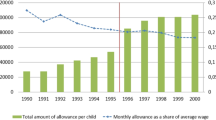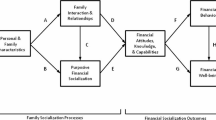Abstract
This article examines the exchange motive in intergenerational monetary transfers. The exchange motive is in operation if parents make transfers to their children in exchange for services. The analysis incorporates data on current inter vivos transfers and the self-assessed probability of making future transfers via bequests. The focus is on the correlation between child-provided help and transfers from parents to adult children. Cross-sectionally, small transfers (between EUR 250 and EUR 5,000) and child-provided help are positively related. Endogeneity arising from omitted variables and reverse causality are addressed by using a lagged value of child-provided help. Further, in an analysis of first-differenced data, the association is statistically significant at the 10% level of confidence. The correlation is not significant in the case of large (above EUR 5,000) transfers, or the self-assessed probability of making future transfers via bequests. These findings suggest that small inter vivos transfers may be driven by exchange motives, although the findings are also consistent with altruism.
Similar content being viewed by others
Notes
Laferrère and Wolff (2006) provide a detailed summary of the theoretical frameworks developed for examining transfer motives.
In the case of both altruism and exchange, the probability of a transfer (Tprob) is negatively related to the child’s income (Yk). In altruism, this relationship follows from the compensatory nature of transfers. In exchange, Yk determines the value of the child’s time (the implicit price of their services).
When the service is informal, the availability of substitutes is unlikely. Therefore, when modelling informal services, assuming inelastic demand is likely to be reasonable and the identification of transfer motives by examining the effect of child income on the value of transfer is potentially possible. An issue, however, with examining very informal services (such as visits and communication) is that the distinction between the service provider and recipient can be unclear. When it comes to more formal types of services, the roles of the two parties are somewhat easier to ascertain (Laferrère and Wolff 2006).
The direction of the effect of S on the value of the transfer (Tvalue), on the other hand, depends on whether the demand for services is own-price elastic or inelastic. If the demand is own-price elastic, Tvalue increases with S, whereas the opposite is the case when demand is own-price inelastic (see Cox and Rank 1992).
ADLs (Activities of Daily Life) include tasks required to take care of oneself and move around using one’s body, whereas IADLs (Instrumental Activities of Daily Life) are made up of activities that people commonly do outside of ADLs (i.e., cooking, household chores, grocery shopping, using the telephone, taking medications and managing finances).
An analysis was carried out checking whether the sample restriction leads to significant differences between the original (full) sample and the final analysis sample. The comparison of both spouses’ age, education level and the household’s number of children between the two samples shows no significant differences, suggesting that sample selection (based on these observable characteristics) is not an issue.
In Wave 1, the question was worded slightly differently: “In the last ten years, have you given the deeds of a house, business, property, or a large amount of money of EUR 5,000 or more to any of your children (or grandchildren)?”. One needs to take into consideration the time disconnect between large transfers (10 years prior) and child-provided help (2 years prior), when interpreting the analysis of the relationship between these two measures.
Alternative specifications presented in Table 11 use a continuous measure of the total daily hours of help that the children provide. Again, the estimated effect of help is statistically insignificant.
If a child and parent have a strong emotional bond, the child is more likely to provide help to the parent and the parent is more likely to make transfers to the child. TILDA contains a question about the number of their children that the respondents “feel very close to”. An emotional closeness measure is constructed by dividing the number of children the respondent reports feeling very close to by the total number of children they have. The mean value of this measure is 91% (see Table 5). The small inter vivos models were re-estimated using Wave 2 data with the inclusion of the emotional closeness variable. The estimates are presented in Models 1 and 2 in Table 12. The results reveal no significant impact of the emotional closeness measure on transfer behaviour, and the estimates of the effect of S are largely unchanged. Estimates obtained using Wave 1 data are virtually identical to the Wave 1 models of Tables 6 and 10. Wave 2 of TILDA measures the respondents’ personality type. A widely-used measure of personality, the “big five”, divides aspects of personality into five traits: extraversion, agreeableness, conscientiousness, emotional stability, and openness to experience (Cobb-Clark and Schurer, 2012). The household head’s score in relation to these five traits is included in the models of small inter vivos transfers, presented in Models 3 and 4 of Table 12. The estimates are similar to those of the initial specifications, with no significant change to the estimated effects of S. As well as including the personality variables together, the models were also re-estimated with each personality measure included individually. The findings remain virtually identical.
References
Alessie, R., Angelini, V., & Pasini, G. (2014). Is it true love? Altruism versus exchange in time and money transfers. Délelőtt Economist, 162(2), 193–213.
Andreoni, J. (1989). Giving with impure altruism: Applications to charity and ricardian equivalence. Journal of Political Economy, 97, 1447–1458.
Andreoni, J. (1990). Impure altruism and donations to public goods: A theory of warm-glow giving. The Economic Journal, 100(401), 464–477.
Arrondel, L., & Masson, A. (2001). Family transfers involving three generations. The Scandinavian Journal of Economics, 103(3), 415–443.
Arrow, K., (1975). Gifts and exchanges. In E. Phelps (Ed.) Altruism, morality and economic theory. New York: Russell Sage Foundation.
Barrett, A., Savva, G., Timonen, V., & Kenny, R. A. (2011). Fifty plus in Ireland 2011: First results from the Irish Longitudinal Study on Ageing (TILDA). Dublin: Trinity College Dublin.
Barro, R. J. (1974). Are government bonds net wealth? Journal of Political Economy, 82(6), 1095–1117.
Becker, G. S. (1974). A theory of social interactions. Journal of Political Economy, 82(61), 1063–1093.
Becker, G. S. (1981). A treatise on the family. Cambridge, MA: Harvard University Press.
Bernheim, B. D., & Severinov, S. (2003). Bequests as signals: An explanation for the equal division puzzle. Journal of Political Economy, 111(4), 733–764.
Bernheim, B. D., Shleifer, A., & Summers, L. H. (1985). The strategic bequest motive. Journal of Political Economy, 93(6), 1045–1076.
Bound, J., Brown, C., & Mathiowetz, N. (2001). Measurement error in survey data. Handbook of Econometrics 5, (3705–3843.
Chamberlain, G. (1980). Analysis of covariance with qualitative data. The Review of Economic Studies, 47(1), 225–238.
Cobb-Clark, D. A., & Schurer, S. (2012). The stability of big-five personality traits. Economics Letters, 115(1), 11–15.
Cox, D. (1987). Motives for private income transfers. Journal of Political Economy, 95(3), 508–546.
Cox, D., & Rank, M. R. (1992). Inter-vivos transfers and intergenerational exchange. Review of Economics and Statistics, 74(2), 305–314.
Gale, W. G., & Scholz, J. K. (1994). Intergenerational transfers and the accumulation of wealth. Journal of Economic Perspectives, 8(4), 145–160.
Greene, W. H. (2003). Econometric analysis. New Jersey: Prentice Hall.
Hochguertel, S., & Ohlsson, H. (2009). Compensatory inter vivos gifts. Journal of Applied Econometrics, 24(6), 993–1023.
Horioka, C. Y., Gahramanov, E., Hayat, A., & Tang, X. (2018). Why do children take care of their elderly parents? Are the Japanese any different? International Economic Review, 59(1), 113–136.
Jürges, H. (2001). Do Germans save to leave an estate? An examination of the bequest motive. The Scandinavian Journal of Economics, 103(3), 391–414.
Kohli, M., & Künemund, H. (2003). Intergenerational transfers in the family: What motivates giving? In V. L. Bengtson, A. Lowenstein, (eds.) Global Aging and Challenges to Families. (pp. 123–142). Oxon: Routledge.
Kotlikoff, J., & Summers, L. H. (1981). The role of intergenerational transfers in aggregate capital accumulation. Journal of Political Economy, 89, 706–732.
Laferrère, A., & Wolff, F. C. (2006). Microeconomic models of family transfers. In S. C. Kolm, J. M. Ythier, (eds.) Handbook of the economics of giving, altruism and reciprocity. (pp. 889–969). Amsterdam: Elsevier.
McGarry, K. (1999). Inter vivos transfers and intended bequests. Journal of Public Economics, 73(3), 321–351.
McGarry, K., & Schoeni, R. F. (1997). Transfer behavior within the family: Results from the Asset and Health Dynamics Study. The Journals of Gerontology Series B: Psychological Sciences and Social Sciences, 52(Special Issue), 82–92.
Menchik, P. L. Modelling the accumulation and distribution of wealth. Unequal estate division: Is it altruism, reverse bequests, or simply noise? (105–116). New York: Oxford University Press.
Modigliani, F. (1988). The role of intergenerational transfers and life cycle saving in the accumulation of wealth. Journal of Economic Perspectives, 2(2), 15–40.
Nordblom, K., & Ohlsson, H. (2011). Bequests, gifts, and education: Links between intergenerational transfers. Empirical Economics, 40(2), 343–358.
Norton, E. C., & Taylor, D. H. (2005). Equal division of estates and the exchange motive. Journal of Aging & Social Policy, 17(1), 63–82.
Norton, E. C., & Van Houtven, C. H. (2006). Inter-vivos transfers and exchange. Southern Economic Journal, 73(1), 157–172.
Ohlsson, H., Roine, J., & Waldenström, D. (2014). Inherited wealth over the path of development: Sweden, 1810–2010. No 2014:7 Working Paper Series, Uppsala Center for Labor Studies, Department of Economics, Uppsala University.
Perozek, M. G. (1998). A reexamination of the strategic bequest motive. Journal of Political Economy, 106(2), 423–445.
Piketty, T. (2011). On the long-run evolution of inheritance: France 1820–2050. The Quarterly Journal of Economics, 126(3), 1071–1131.
Verbeek, M., (2008). A guide to modern econometrics. Chichester: John Wiley & Sons Ltd.
Author information
Authors and Affiliations
Corresponding author
Rights and permissions
About this article
Cite this article
Nivakoski, S. Does the exchange motive influence intergenerational transfers? Evidence from Ireland. Rev Econ Household 17, 1049–1079 (2019). https://doi.org/10.1007/s11150-018-9422-4
Received:
Accepted:
Published:
Issue Date:
DOI: https://doi.org/10.1007/s11150-018-9422-4




